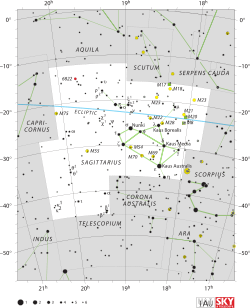Pi Sagittarii

| |
| Observation data Epoch J2000.0 Equinox J2000.0 | |
|---|---|
| Constellation | Sagittarius |
| Right ascension | 19h 09m 45.83293s[1] |
| Declination | –21° 01′ 25.0103″[1] |
| Apparent magnitude (V) | +2.89[2] |
| Characteristics | |
| Spectral type | F2 II[2] |
| U−B color index | +0.22[3] |
| B−V color index | +0.35[3] |
| Astrometry | |
| Radial velocity (Rv) | –9.8[4] km/s |
| Proper motion (μ) | RA: –1.36[1] mas/yr Dec.: –36.45[1] mas/yr |
| Parallax (π) | 6.40 ± 0.43[1] mas |
| Distance | 510 ± 30 ly (160 ± 10 pc) |
| Details | |
| Mass | 5.9 ± 0.3[2] M☉ |
| Surface gravity (log g) | 2.21 ± 0.05[2] cgs |
| Temperature | 6,590 ± 50[2] K |
| Rotational velocity (v sin i) | 30[5] km/s |
| Age | 67[2] Myr |
| Other designations | |
Pi Sagittarii (Pi Sgr, π Sagittarii, π Sgr) is a triple star system in the zodiac constellation Sagittarius. It has the traditional name Albaldah.[7]
Albaldah has an apparent visual magnitude of +2.89,[2] which is sufficiently bright to be readily seen with the naked eye. Based upon parallax measurements, this star is located at a distance of roughly 510 light-years (160 parsecs) from Earth.[1] Because it is close to the ecliptic, Albaldah can sometimes be occulted by the Moon, and, very rarely, planets of the Solar System. The next occultation by a planet takes place on February 17, 2035, when it will be occulted by Venus.[8]
The spectrum of this star matches a stellar classification of F2 II.[2] The 'II' luminosity class is for a bright giant star that has exhausted the hydrogen at its core and has followed an evolutionary track away from the main sequence of stars like the Sun. Because it has nearly six times the mass of the Sun,[2] it reached this stage in a mere 67 million years.[2] The outer envelope is radiating energy at an effective temperature of about 6,590 K,[2] giving it the yellow-white hue of an F-type star.[9]
Pi Sagittarii has two nearby companions. The first is located at an angular separation of 0.1 arcseconds from Albaldah, or at least 13 Astronomical Units (AU). The second is 0.4 arcseconds away, which is 40 AU or more. Nothing is known about the orbits of these stars.[10]
Name and etymology
- The name Albaldah is comes from the Arabic بلدة bálda 'the town'.[10] In the catalogue of stars in the Calendarium of Al Achsasi al Mouakket, this star was designated Nir al Beldat, which was translated into Latin as Lucida Oppidi, meaning the brightest of the town.[11]
- This star, together with ζ Sgr and σ Sgr may have been the Akkadian Gu-shi-rab‑ba, the Yoke of the Sea.[7]
- In Chinese, 建 (Jiàn), meaning Establishment, refers to an asterism consisting of π Sagittarii, ξ² Sagittarii, ο Sagittarii, 43 Sagittarii, ρ¹ Sagittarii and υ Sagittarii. Consequently, π Sagittarii itself is known as 建三 (Jiàn sān, English: the Third Star of Establishment.)[12]
References
- ↑ 1.0 1.1 1.2 1.3 1.4 1.5 van Leeuwen, F. (November 2007), "Validation of the new Hipparcos reduction", Astronomy and Astrophysics 474 (2): 653–664, arXiv:0708.1752, Bibcode:2007A&A...474..653V, doi:10.1051/0004-6361:20078357
- ↑ 2.0 2.1 2.2 2.3 2.4 2.5 2.6 2.7 2.8 2.9 2.10 Lyubimkov, Leonid S. et al. (February 2010), "Accurate fundamental parameters for A-, F- and G-type Supergiants in the solar neighbourhood", Monthly Notices of the Royal Astronomical Society 402 (2): 1369–1379, arXiv:0911.1335, Bibcode:2010MNRAS.402.1369L, doi:10.1111/j.1365-2966.2009.15979.x
- ↑ 3.0 3.1 Nicolet, B. (1978), "Photoelectric photometric Catalogue of homogeneous measurements in the UBV System", Astronomy and Astrophysics Supplement Series 34: 1–49, Bibcode:1978A&AS...34....1N
- ↑ Wilson, R. E. (1953), General Catalogue of Stellar Radial Velocities, Carnegie Institute of Washington, D.C., Bibcode:1953GCRV..C......0W
- ↑ Bernacca, P. L.; Perinotto, M. (1970), "A Catalogue of Stellar Rotational Velocities", Contributi Osservatorio Astronomico di Padova in Asiago 239 (1), Bibcode:1970CoAsi.239....1B
- ↑ "CCDM J19098-2101AB -- Double or multiple star", SIMBAD (Centre de Données astronomiques de Strasbourg), retrieved 2012-01-15
- ↑ 7.0 7.1 Allen, R. H. (1963). Star Names: Their Lore and Meaning (Reprint ed.). New York: Dover Publications Inc. p. 355. ISBN 0-486-21079-0. Retrieved 2012-09-04.
- ↑ Grego, Peter (2008), "7. Observing Venus", Venus and Mercury, and How to Observe Them, Astronomers' Observing Guides, pp. 229–247, doi:10.1007/978-0-387-74286-1_7
- ↑ "The Colour of Stars", Australia Telescope, Outreach and Education (Commonwealth Scientific and Industrial Research Organisation), December 21, 2004, retrieved 2012-01-16
- ↑ 10.0 10.1 Kaler, James B., "ALBALDAH (Pi Sagitarii)", Stars (University of Illinois), retrieved 2012-01-21
- ↑ Knobel, E. B. (June 1895). "Al Achsasi Al Mouakket, on a catalogue of stars in the Calendarium of Mohammad Al Achsasi Al Mouakket". Monthly Notices of the Royal Astronomical Society 55: 429. Bibcode:1895MNRAS..55..429K. doi:10.1093/mnras/55.8.429.
- ↑ (Chinese) AEEA (Activities of Exhibition and Education in Astronomy) 天文教育資訊網 2006 年 5 月 11 日
| ||||||||||||||||||||||||||||||||||